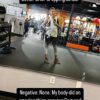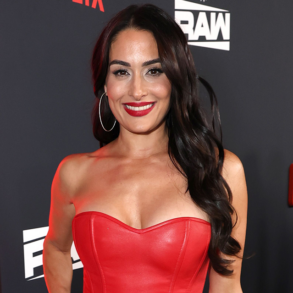
Among the things that differentiate us from our primate ancestors are not only our big brains but our big butt muscles—or, as Stephanie P. Marango, M.D., a physician and anatomy expert in New York City, puts it, our well-developed gluteus maximus. “That ability to be bipedal is a huge deal,” she says. “And it’s this muscle that is really doing a major component of that.”
It’s ironic, then, that the largest muscle in the human body, which has given humans their signature upright strut, spends most of the day metaphorically sitting on its butt. (See: Why Your Glute Workouts Aren’t Working)
Meet Your Butt Muscles
No matter what anyone’s butt looks like on the outside, they all look more or less the same on the inside. Ready for a little butt muscle anatomy lesson? Here are the three main butt muscles that make up your glutes:
- Gluteus minimus: The smallest glute muscles are directly under the gluteus medius. It abducts your leg (moves it away from the center of the body) and rotates your leg inward.
- Gluteus medius: This pork chop-shaped butt muscle sits near the outside of your pelvis. Like the gluteus minimus, it abducts and rotates your leg inward.
- Gluteus maximus: True to its name, the maximus is the biggest muscle in your body. Its job is to extend your hip (think: what’s happening in your hip during the upward motion of a squat) and to rotate your leg outward.
The gluteus maximus gets all the attention, but the medius and minimus also do an important job in addition to those listed above. “They’re responsible for stabilizing your pelvis when you walk or anytime you’re off balance,” says Herrera. Stand up and balance on one leg—yep, your glute med and min just kicked in.
Genetics & Glute Shape
Everyone’s gluteal muscles attach at the same points on their skeleton—the maximus runs diagonally from the top of the pelvis to the femur and iliotibial band on the outside of the upper thigh.
But that means, if you have a tall pelvis, “you may have a longer, squarer shape to your posterior,” says Kimberly Topp, Ph.D., chair of the Department of Physical Therapy at the University of California, San Francisco. “With a wide pelvis, you may have a more horizontal orientation of the butt muscles.” If your back is more curved, your buns may appear more lifted.
Translation: You can work on your glutes and change their size and shape (more on that later), but some people start with more naturally rounded gluteal muscles and others have butt muscles that are shaped differently.
So just how much of your butt shape is predetermined by genetic roulette? Up to 70% of the body’s overall shape (and therefore your butt’s shape) is genetic, says Marango. “The rest is going to be influenced by nutrition, exercise, sleep, posture—anything outside your genetic code.” You can thank our gender for the fact that women generally have more posterior padding than men and thank Mom and Dad for where that padding tends to congregate.
But no matter what shape of butt you start with, it will morph later in life. At the same body mass index, a woman of 50 has a flatter butt profile than a woman half her age because shifting hormone levels post-menopause signal the body to store fat in the belly rather than the buns, according to Matthew P. Reed, Ph.D., a research associate professor at the University of Michigan in Ann Arbor who studies body shape. “You’ll see less fat at the side of the butt and more up at the iliac crest at the top of the pelvis,” he says. “That’s why pants don’t fit the same way as you get older.”
The good news? You can give gravity a good run for its money by building strong butt muscles and keeping them that way. (BTW, Kim K’s trainer is spilling her best barbell squat secrets here.)
How to Build Stronger Butt Muscles
If your heart is set on bigger or rounder glutes, and “if you’re willing to spend the time on it, you have a lot of possibilities to change the shape of your buttocks,” says Topp.
In general, the gluteus maximus is a combination of fast-twitch muscle fibers—or rapid-firing fibers, which are tapped for bursts of speed or power—and slow-twitch muscle fibers, which are the workhorses during aerobic activities. Some studies suggest that the gluteus medius and minimus consist primarily of slow-twitch muscles. This means the butt muscles can benefit from both strength training with high load and low reps, like heavy-weight squats (to work fast-twitch muscles), and low load and high reps and endurance exercises like running and stair climbing (to work slow-twitch muscles). That said, there are a bunch of non-squat strength moves key for building stronger glutes and it’s a good idea to add glute activation drills to the beginning of your workouts, too, to make sure all muscles are firing.
Of course, a big part of your butt’s appearance is dictated by the layer of fat that covers those glutes (all the better to twerk with, amirite?). “Much of the female posterior is adipose [fat] tissue,” says Reed. “The actual muscles are shaped like men’s, if a little different in orientation because the pelvis is slightly wider.”
If your goal is to lose fat for stronger, rounder butt muscles, your surest bet is to follow a healthy calorie-appropriate diet (here’s how to determine your optimal calorie intake) and add regular cardio or HIIT on most days to lose fat all over. (Again, if that’s your goal.) If you want to build muscle, adjust your calorie intake and strength-training workouts accordingly.
Just remember, if you’re dead-set on using diet and exercise to change the ability and appearance of your glutes, you’re working toward the best butt muscles for your body. And that should be the goal—not J.Lo’s or the one belonging to that woman in front of you at yoga class. “People say ‘I want her butt,’ but you can’t have it, and you shouldn’t want it,” says Marango. “Instead, within your own structure, maximize what you have.”
And that’s something any of us who is willing to get off her butt and move it can do. (But let it be known: It is possible to work your butt too much.)
This post was originally published on this site be sure to check out more of their content.









